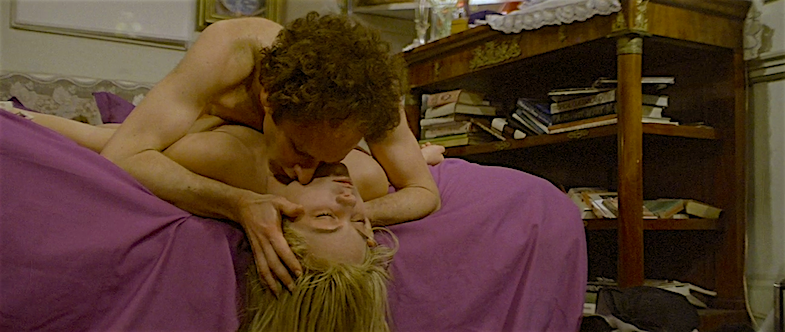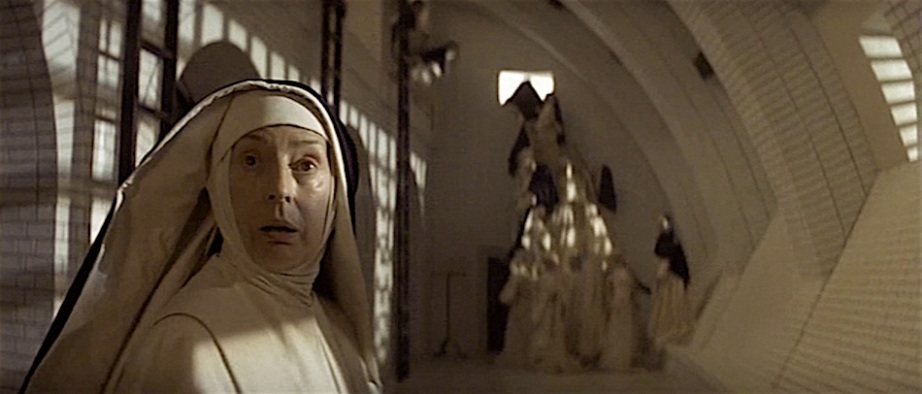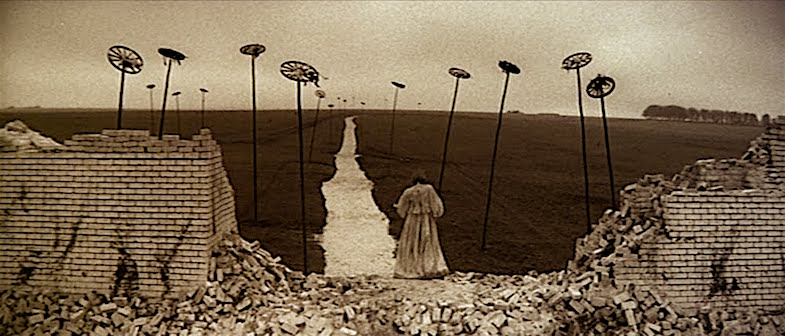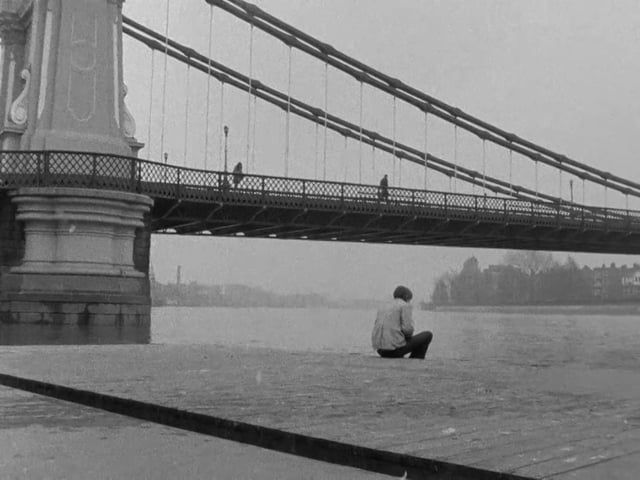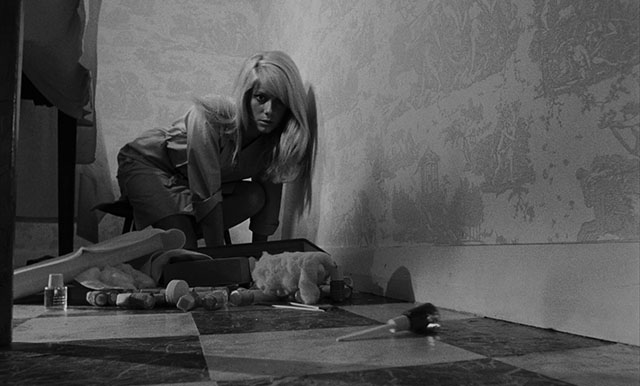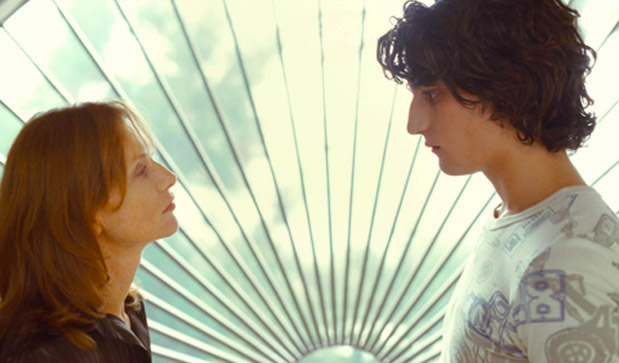“I was wondering if you could do me a favor and write a think piece on Polanski’s Repulsion? Perhaps you could post it on your blog. I’d really appreciate it.”

“The nightmare world of a virgin’s dreams becomes the screen’s shocking reality!”
REPULSION
Roman Polanski, 1965
This request brought me back to my college daze. An English Major, during my sophomore year a professor challenged me to form my semester thesis on Nathaniel Hawthorne’s Scarlet Letter. The challenge was not the thesis, but the actual assignment:
Create a thesis “with something new” to offer about the Scarlet Letter.
An odd and somewhat cruel way to make or break my grade. I wanted to bang my then-stoner-head into a wall. I took a real leap into my deconstruction of Hawthorne’s novel. And, I pulled out all the stops.

On her way up to the flat she shares with her sister, Carol bites her nails. I was doing something similar as I tried to find something “new” in “The Scarlet Letter”
Catherine Deneuve
REPULSION
Roman Polanski, 1965
Cinematography | Gilbert Taylor
My thesis argued that the book was an account of actual demonic possession. As I made my presentation to a class full of actual adults, I was met with snickering and eye-rolling. However, I had strange supporting information for every question designed to make me look the idiot. In the end, the professor gave me a “B.”
Not a horrible grade, but this was an advanced course in which I was the only student not yet working on their Masters. It was the lowest grade I ever received in a literature course. A year later I asked this professor why he gave me such a task. His answer? The conversation went something like this:
“I wanted to take you down a peg or two. I didn’t feel a Sophomore should have been in that class.”
“So you wanted to humiliate me by having me read a book normally studied in Freshman year?”
“Yes and I wanted to give you an impossible assignment. I had no intention of failing you. My plan was to give you a “C” no matter what you presented.”
“You gave me a ‘B.‘”
“Yes. Your thesis was absurd, but you supported it well. I almost gave you an ‘A-‘ but your ridiculous rebellion against grammar would not allow me that opportunity.”
The following semester I discussed this with another professor who would become my university mentor and friend until her death in the mid-1990’s. She indicated that my experience was actually a surprising compliment from that professor.
So when an individual of some note asked me to write a piece about Roman Polanski’s Repulsion, I had to laugh. What can one possibly write about that infamous film that hasn’t been written about six million times before? I thought about it and politely declined. But as it turns out there is a strangely valid reason for this person’s request.
And so I now ask for your indulgence as I attempt to take another exploration into Repulsion.

Catching her reflection in a vase, Carol seems transfixed by the contour’s warped perspective.
Catherine Deneuve
REPULSION
Roman Polanski, 1965
Cinematography | Gilbert Taylor
It speaks volumes that 50 years after it first screened, Repulsion continues to not only entertain, but unnerve audiences. Roman Polanski’s first English-speaking film is at simultaneously experimental and resoundingly accessible. It also happens to be one of the most intimately disturbing films ever made. The intimacy of this film emanates not only from the style in which it is crafted but also from a universally shared fear of losing grasp with our own perception of reality. The film gradually pulls us into the protagonist’s hysteria leaving the viewer disoriented and distressed. I do not care for the term “hysteria” but I think it is perfectly suited here. By the time Polanski’s grim little movie comes to its ambiguous ending and circular cinematic “logic,” it is impossible to not relate to Catherine Deneuve’s character.
This resonation is the film’s most horrific element: deep down we all worry that sanity is just a few pegs away from leaving us alone, isolated and afraid beyond recognition.
Roman Polanski has always refused to answer direct questions about what we are seeing or how we are to interpret what is shown. While this is a smart move for any filmmaker, I suspect Polanski’s refusal is actually deeply valid. Certainly the movie is about a young woman going insane, but questions about “reality” vs. “hallucination” or simply “Surrealism” continue to form Repulsion‘s Film Theory discussion. However, the idea that Polanski himself was not entirely sure of what he was striving to present fails to hold water. Roman Polanski is far too intelligent a filmmaker and Repulsion is far too acutely acted, set-up and edited to have come from an unsure footing.

Moving closer is the vase’s distortion somehow more aligned with Carol’s perceptions?
Catherine Deneuve
REPULSION
Roman Polanski, 1965
Cinematography | Gilbert Taylor
I’ve read so many essays on this film. I would not know how to reference all of the different theories. These range from “Feminist Statement” to “It all really happens!” to “Childhood Rape Survivor / PTSD” all the way down to Cinematic Metaphor on a wide range of topics. One of the many metaphors tied to the film is the Counter-Cultural Impact of the 1960’s. Another ties the film to Sexual Revolutionary Reaction. Going even further beneath the surface of the film’s simple complexity have been theories about the actual meaning of the protagonist’s name. I must admit that even the most far-out theories interest me. The way we deconstruct artwork is always interesting and revealing.
Perhaps the most valid of the many theories is grounded in three Polanski films that are often referred to as The Apartment Horror Trilogy. One would have a hard time arguing against the connections between Repulsion, Rosemary’s Baby and The Tenant. All three of these films play with senses of perception, claustrophobic induced fears, paranoia and insanity. Then of course there is the knee-jerk tendency to connect Polanski’s profoundly horrific childhood, the devastating tragedy he endured in the late 1960’s and his personal sexual transgressions of the 1970’s which led him into exile. Certainly an artist’s life experience will color his/her work, but unless the artist is willing to discuss the connection — it really feels inappropriate to read the personal into the work. And yet can we just dismiss the facts that two of the characters are immigrants, deal with sexual confusion, are put in the position of outsiders and all fall prey to paranoia.
But my personal concept of this strangely timeless film is tied to perception. A deeply warped and disassociated perception that has been manifesting within the mind that when faced dead-on with confrontation, loneliness and isolation triggers a spasm into the darkest corners of insanity. The most telling signals Polanski delivers, with a great deal of assistance from Gilbert Taylor’s cinematography, are the ways in which he starts and ends the film. The first thing we see on the screen is Carol’s eye in extreme close-up. As the camera pulls back we realize that we are seeing Deneuve’s “Carol” staring out into space. She is clearly not looking at anything, yet there is something “off” about her expression. It hints that she might be looking at something which is not visible to us. In reality, she has sort of spaced-out during application of a manicure in the beauty salon that employees her.

The opening shot…
REPULSION
Roman Polanski, 1965
Cinematography | Gilbert Taylor
Her client, her co-worker and her boss all seem to think she is caught in the dewy haze of love. The pretty manicurist is daydreaming of her Prince Charming. If only they knew. Carol is an immigrant and she lives with her sister, Helene, in a fairly spacious and charming apartment. It is important to note that Carol’s apartment is simple and it appears spacious. However, after we enter the apartment with Carol it is clear that it is not all that large. Upon entering this home which will soon morph into a sort of self-imposed prison of horrors, we note that the entry way is short. The living room is off to the immediate left, the kitchen off to the immediate right. The hallway leads to the modern bathroom. The bedrooms appear at first to be opposite each other at the end of the hall.

Carol’s “safe place” quickly transforms into a living, breathing, shape-shifting space of horrors.
REPULSION
Roman Polanski, 1965
Cinematography | Gilbert Taylor
It is also interesting to note that the apartment is appointed with furniture that would have most likely been accumulated from various sources. Only Carol’s elder sister seems to have taken the time to actually fashion a look for her bedroom. Both young women still have remnants of childhood in their respective rooms. However, there is an important difference between Carol and Helenes’ rooms: Helen has a couple of stuffed animals, but a sexy feminine atmosphere. Carol’s room is oddly void of personality. Yet there a few things of note: a child’s night lamp and a sense of untidiness. The living room has a cluttered collection of items which we can safely assume have all been placed by Helene. Life, Marie-Claire and gossip magazines lay near a simple turntable/radio with some 45’s and a couple of record albums. Judging by the way we will later see Carol rummage through the items in the living room — none of these things are hers and none seem to interest her. Except for one item.
It is Polanski’s repeated return to this item that it is clear that is great meaning here. An old childhood family photograph which we will later learn was taken in Brussels. This photograph seems draw Carol’s attention. She clearly wants to look it, but it seems to hold a threat within the borders of the frame.

A childhood family portrait taken in Brussels…
REPULSION
Roman Polanski, 1965
Cinematography | Gilbert Taylor
Early in the film Helene points out that Carol needs to be more social. She needs to get out more and meet people. As Helene begins to prepare a meal with a freshly skinned rabbit as the core component, Carol seems to only be interested in two things: Helene’s boyfriend who has begun to leave his personal items in Carol’s bathroom glass and a crack springing out from what appears to be some sort of kitchen ventilation screen. Helene has little patience for Carol’s dislike of her boyfriend. An impatience which we later will understand comes from the fact that Helene is dating a married man.
When Carol studies the crack in the kitchen wall she mutters, “I must get this crack mended.” Helene only briefly appears to be concerned by the comment. It is only with hindsight that the viewer wonders if that initial crack was ever there in the first place. Helene’s boyfriend is loud, jovial and more than a bit of a flirt. He clearly disgusts Carol. When he dismisses the idea of eating a rabbit dinner, he promises to take Helene out on the town for a grand meal. Helene quickly places the skinned and seasoned rabbit in the tiny kitchen refrigerator. Carol is clearly upset that Helene is leaving her alone in the apartment but refuses to admit it. As Helene and her man step into the elevator to leave for some fun he points out that “something” is wrong with Carol and she should see someone. It is the first time we see Helene become upset. Perhaps a little too upset. She seems furious that he would insinuate that anything is wrong with her little sister.

Auto-pilot at the salon…
Catherine Deneuve
REPULSION
Roman Polanski, 1965
Cinematography | Gilbert Taylor
We have already witnessed Carol’s strange manner of falling into her thoughts. She has drifted away while applying nail polish causing the client to ask if she is asleep. Despite this sort of behavior she is able to communicate well with her boss explaining that the salon is out of a particular shade of polish, she is polite and she never appears hostile. If anything, she appears shy but friendly. When we follow her on her lunch break it is clear she is on a sort of auto-pilot as she walks. The only things that cause her to snap out of her “daydreaming” are the sexual catcalls that greet her as she passes a street construction crew.
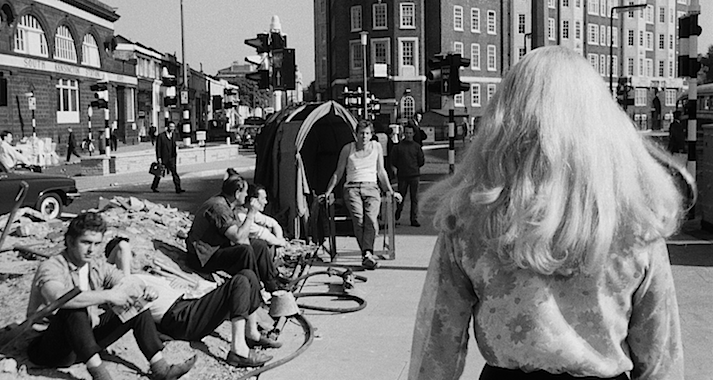
A quiet walk seems to be an open invitation to sexual advances…
Catherine Deneuve faces the catcalls.
REPULSION
Roman Polanski, 1965
Cinematography | Gilbert Taylor
The initial shot shows Carol’s back and working class construction men. But after the catcalling begins, Carol can’t help but glance. Suddenly the camera perspective on the loudest of the crew presents a somewhat distorted shot of the man. The camera’s perspective makes him appear slightly distorted and evil. Of course, anyone would feel uncomfortable in this situation. This male public assertion of sexuality and sexual intent displaces the identity of women. They become nothing more than an object for sex. It is threatening. However, there is something about that camera angle and the way in which Carol reacts that seems to be not quite right.
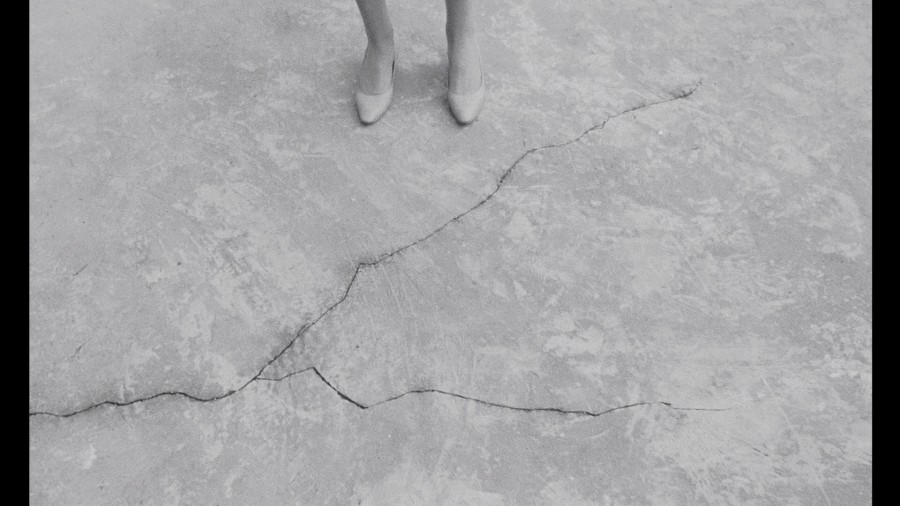
Cracks in the walls and the pavement.
Catherine Deneuve
REPULSION
Roman Polanski, 1965
Cinematography | Gilbert Taylor
The other thing that snaps Carol out of “daydreaming” or zombie-like walking are a couple of cracks in the pavement. These cracks upon the cement ground which Carol treads cause her to halt and study them. It is as if the cracks in the pavement have pulled Carol into another type of “daydream.” So intense is her interest in these cracks, she calmly takes a seat on a public bench and stares at them. This is far more than “daydreaming.” This is at the very least OCD behavior only without any level of energy. Once again with hindsight, one can’t help but wonder what Carol is actually seeing as she stares at the cracks.

What does Carol see in the cracks?
Catherine Deneuve
REPULSION
Roman Polanski, 1965
Cinematography | Gilbert Taylor
Perception and Gilbert Taylor’s cinematography is key to understanding Repulsion. Returning to the film’s opening shot, if one thinks about the way in which Polanski chose to displays the film’s credits — it is clear that was far more than a “creepy” method to indicate a genre. Initially the title and words appear to be coming out from behind the iris of the eyeball, but very quickly any logic to the way the words appear on the screen are not limited to the eye itself. The letters and names float about without any level of logical editing. The credits present themselves in a visually discordant manner. And as the words scroll about the screen, the eyeball and eye socket seem to be twitching, blinking and gaze out and around but not at all in coordination with the words. Actually, if a person only sees this film once there is a feeling that Polanski’s budget has caused the credits to be done in a ramshackle messy manner that might have been intended to be a harmoniously clever horror-genre opener that has failed and simply looks like a poor but ambitious choice. After viewing the film even only once, it clear that these credits and the way in which Deneuve’s eye is reacting is all intentional. There is no connection between the eye and the credits that roll about it.
Throughout the film’s first act, we see Carol’s limited interactions in only a few spaces. Actually, the spaces in which we see Carol interact are essentially limited to three places: The beauty salon, the streets on which she walks and her shared apartment. Polanski and Taylor are careful to pace the presentation of Carol’s perceptions of these spaces and interactions slow enough so that our awareness is initially limited. We visit the salon and the streets about three times. Each time a bit more is revealed. The reveals are not so much about the spaces or interactions as they are about the way in which Carol is perceiving them.
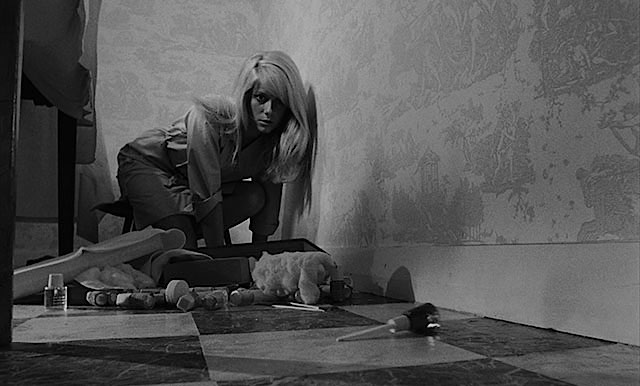
“Are you alright?”
Catherine Deneuve
REPULSION
Roman Polanski, 1965
Cinematography | Gilbert Taylor
The busy beauty salon appears small and a bit cramped. The client, the beautician and Carol barely seem to fit into the room where facials, massages and manicures are performed. But when Carol loses her focus, drifts off and cuts the finger of her client — her tray falls to the ground. Suddenly it appears there is far more space in the room than we initially thought. As Carol stares at a spinning nail polish bottle we become disoriented by Gilbert Taylor’s camera. There is an odd expansion of space and shadow. Carol seems almost animalistic as she watches the spinning bottle. A tiny bottle which due to the placement of camera and use of lens looks bigger than it is.
When her boss inquires about what is wrong, we realize that she has missed three full days of work without having ever called the salon. When pushed for an explanation, Carol clumsily mutters that an “Aunt arrived for a visit unexpectedly.” The salon boss automatically assumes that Carol is telling her that she was ill due to menstruation, it is apparent that this was not the meaning Carol was attempting to imply. As a co-worker helps her into her street clothes she encages Carol in a conversation. She suggests that Carol take in a movie. She manages to bring Carol out of her “shell” and gets her to giggle as the girl describes a scene from a Charlie Chaplin movie she has just seen. Carol seems connected, but her laughter becomes to feel like a nervous reaction. As the girl goes to hand Carol her purse, she notices it is open. She looks inside and discovers the head of the rabbit waiting amongst a compact and lipstick.

Walking without focus and ever-increasing ticks.
Catherine Deneuve
REPULSION
Roman Polanski, 1965
Cinematography | Gilbert Taylor
In the beginning of the film we meet a potential suitor for Carol. Played by John Fraser, this would-be suitor seems harmless enough. This is not to say that he isn’t persistent. He follows Carol on her lunch break. Sits himself down at her table and pushes to get a date. Carol is polite, but clearly not interested. Or is she? She never clearly brushes Colin off. As he follows her back to the salon he presses for a date. She seems shy, but not entirely dismissive. She smiles. The second time she encounters the ever-pushy Colin, she is clearly forcing a smile. Despite his humor and flirtation, she never gives a clear signal. However, most men would let it go. She clearly is not going to fully agree to a date, but Colin presses on.
The viewer’s first time in the sisters’ apartment, we discover that Carol can hear her sister having sex. As Helene reaches orgasm, Carol looks forward toward her sister’s room and covers her ears with her pillow. We know she dislikes Helene’s married boyfriend, but it is never clear why. However, she does not hesitate to toss out his things. When Helene asks Carol why she has thrown out his things, Carol gives a strong declaration that she simply does not like him. However she states this in a passive tone. We have already noticed that his straight razor has caught her eye and thoughts. The second time she notices it she picks it up and studies it. Her face and eyes dulled, she is physically mute of thought.
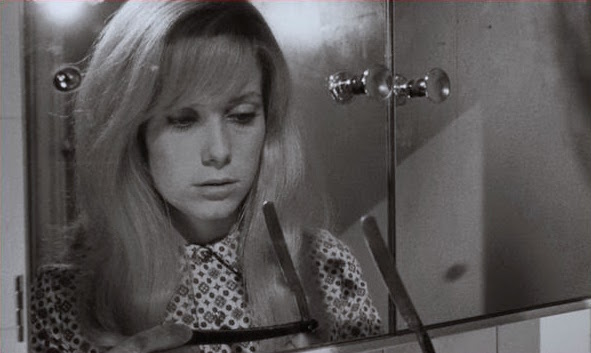
Studying a straight razor.
Catherine Deneuve
REPULSION
Roman Polanski, 1965
Cinematography | Gilbert Taylor
When Helene and her boyfriend leave for a trip to Italy, Carol seems more than a little panicked. How long will they be gone? 10 or 15 days. Maybe. Carol’s need for more rigidly defined dates is not just for reassurance, it is as if despair and fear demand it. Helene refuses to cater to the silly insecurities of her grown sister. But as the two leave, Carol is clearly concerned. As much as she despises Helene’s boyfriend, she’d rather put up with him than be without her sister.
She is physically repulsed by Helene’s boyfriend. Even the scent of an undershirt makes her vomit. Yet when she pulls out the plate of uncooked rabbit, she stares at it in the same way she has stared at the cracks and the straight razor. There is no clear indication of what she might be thinking, but she is not repulsed. The scent of an undershirt makes her ill, but as the rabbit begins to rot in the living room it causes her no concern. The phone rings and we discover she has the straight razor which she sits on the rabbit’s plate. As we will soon learn, she uses that razor to cut off the rabbits head. A head which she stores in her purse.

Sister’s uncooked rabbit does not seem to bother Carol, but something about the bunny’s head is of particular interest. The first use of the straight razor.
Catherine Deneuve
REPULSION
Roman Polanski, 1965
Cinematography | Gilbert Taylor
Looking back earlier in the film after her sister leaves for Italy, Carol walks about the apartment. She looks at the family photograph. She glances through her sister’s record collection. She walks into her sister’s bedroom. She looks around. She approaches her sister’s wardrobe. She opens the door and examines one of Helene’s sexy dresses. Carol seems to study the dress. As she moves the wardrobe’s mirrored door, we catch a quick glimpse of a man’s reflection behind her. It is a jarring moment. Without any sort of musical cue, it is a scene that never fails to make me jump.
It is shortly after this that the audience is put in the position of not knowing if the steps Carol seems to hear in her apartment are actually in her apartment or in one above or below. No, they must be in her apartment. We notice that her wardrobe is blocking a thus far unknown door. A light goes on behind that door. It may not always become obvious to the viewer upon the first viewing of the film, but this door is suspect. Where does it lead? Carol’s bedroom is opposite from Helene’s. Isn’t it? Wait, are the two bedroom now next to each other? Later those steps behind that door will force the door open — pushing Carol’s wardrobe out of the way. The man who emerges rapes Carol.

Sometimes the hall’s walls turn into a flesh-like surface. Other times aggressive male arms emerge to ravage and rape Carol.
Catherine Deneuve
REPULSION
Roman Polanski, 1965
Cinematography | Gilbert Taylor
There is no question that these are rapes. But there no confusing the fact that Carol has imagined them. There is a bit of confusion regarding her reactions to these sexual violations. She seems at once horrified and aroused. We know these rapes are rape fantasies. We know this because we have seen Carol rush from her sister’s bedroom into the hall. She touches the hall wall and it appears to be a soft porous surface in which her hands leave an impression. Wait. Is the hall suddenly a wall of flesh? Soon arms will emerge from the wall body and seemingly sexual violate Carol. Once again, her reaction is a mix of shock, horror and possibly sexual pleasure. Later she will walk down the hallway which fills with outreaching, grabbing male arms.

A walk down the hall becomes a sexual threat that offers no escape.
Catherine Deneuve
REPULSION
Roman Polanski, 1965
Cinematography | Gilbert Taylor
During one particularly brutal rape, the screen fades to black. When we return we find Carol laying nude on the floor of the hall. She does not look traumatized. It is actually the only time in the film that Carol looks relaxed. A jarring phone ring will snap her back into a state of frenzied paranoia and fear. The cracks are getting worse. They are no longer limited to just the two in the kitchen. At one point Carol cautiously approaches the childhood family photograph. As we see discomfort and fear grip her eyes and body, the wall behind the photograph cracks apart threatening to crumble to pieces. Carol flips on a light only to see the entire wall crack apart.

She had planned on getting the crack in the kitchen mended, but new cracks are emerging everywhere.
Catherine Deneuve
REPULSION
Roman Polanski, 1965
Cinematography | Gilbert Taylor
As Carol descends into insanity her perspective has taken over every aspect of the apartment’s space. After her desperate suitor has attempted to call her over and over again, he has a few drinks and works up the nerve to show up at her front door. The once pushy, but somehow nice guy suddenly takes on a threatening aspect. Carol looks through her front door peep hole and so does Gilbert Taylor’s camera. Distorted and furious, Colin demands that Carol open the door or he will bust it down.
Turns out this is not an idle threat. He lunges at the door. Carol backs away from the door. She reaches for a heavy metal candle stick. Her once kindly suitor breaks through the front door’s lock and busts into Carol’s warped space. Even though he tries to apologize for his behavior and expresses his love and desire for Carol, it is too late. He is a threat. He is danger. The small entry way no longer appears small. It seems very dark and long. The camera’s perspective reveals a nosy elderly neighbor looking in as Colin tries to defend his actions.

Does this potential suitor really have good intentions? If so, why did he break the door’s lock to secure access to Carol’s apartment? A nosy neighbor watches from the hall.
John Fraser & Catherine Deneuve
REPULSION
Roman Polanski, 1965
Cinematography | Gilbert Taylor
Carol refuses to make eye contact. When Colin notices the old neighbor spying on them, he walks down the once short entry way, the elderly woman rushes into her apartment. As he attempts to close the door, Carol’s fear turns to rage.

He just wants to be “with her.” Metal candlestick at the ready…
John Fraser & Catherine Deneuve
REPULSION
Roman Polanski, 1965
Cinematography | Gilbert Taylor
Carol is no longer passive. She brutally attacks her suitor. Putting all her force into it, Carol bludgeons Colin to death. Blood splatters all over the door. Carol does not seem to be concerned that she has just murdered someone, but she is very upset by the sight of blood coming out of his ear and staining the door. She drags Colin down the ever-expanding hallway and manages to get his body into the tub of water that she had drawn earlier and had allowed to overflow. Suddenly full of manic energy, Carol uses the candlestick to hammer a shelf she pulls from the kitchen to act as a barricade for the apartment entryway.
It isn’t long before the landlord shows up. Carol gives us a peep hole view of Patrick Wymark. Like Colin, the landlord must bust his way into the apartment. At first angry at the state of the apartment, he quickly changes his tune as he looks at Carol in her almost sheer night gown. Soon rage gives way to lechery.

Peephole perspective: the unwanted visit from the landlord.
Patrick Wymark
REPULSION
Roman Polanski, 1965
Cinematography | Gilbert Taylor
As he brutishly attempts to mount Carol, she pulls out the straight razor and viciously begins slashing him. Filmed in black and white with Catherine Deneuve’s maniacal slashing, blood spurts everywhere. It only takes a few minutes before it is clear that Carol has hit some vital veins.

“You would not even have to worry about the rent…”
Patrick Wymark propositions Catherine Deneuve
REPULSION
Roman Polanski, 1965
Cinematography | Gilbert Taylor
She has committed her second murder. Once again, she seems more concerned with the mess than the murder. She pushes the sofa over on top of the dead landlord to hid him and his mess from her view.
Insanity has almost completely taken over. As we see Carol sitting in the once small and modern bathroom, we notice that the tub is no longer directly next to the bathroom door. The tiled walls are gone. The bathroom looks old, wet and moldy. It also appears to go deeper than possible. This is not the bathroom we have seen before. Welcome to Carol’s perspective.
Over the course of the film nearly every aspect of Carol’s apartment has been shifted, re-shaped, extended, shortened, architecturally re-arranged and bent to fit within Carol’s skewed perception. It isn’t until Helene and her boyfriend return from their holiday that the apartment’s spacial and visual aspects are fully formed back into the spaces to which we were first introduced. In other words, as Helen enters the wrecked blood stained apartment that “reality” returns to our perspective.
As our realistic perspective returns we discover that Carol has slipped far beneath insanity. Her eyes appear to be frozen open. She almost appears to be dead. But in the most horrifying way, our protagonist has slipped into something far worse than death. She is found under her bed in a catatonic state. While we are given no clear indicators, it feels as if this will be the state she will remain. Can there be anything more terrifying than be shut off from reality and stuck in the darkest and murky waters of a ill mind.
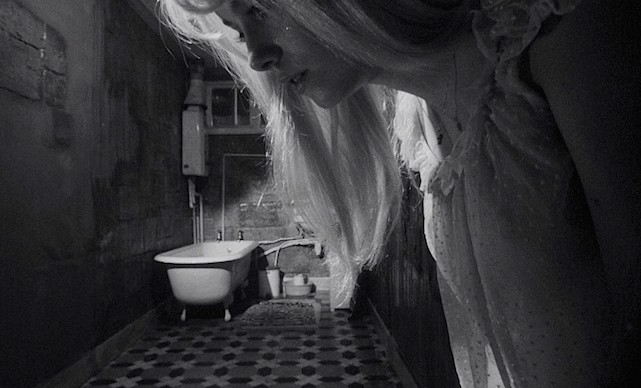
There are more than a few things wrong with this “picture.”
Catherine Deneuve
REPULSION
Roman Polanski, 1965
Cinematography | Gilbert Taylor
As brilliant as Roman Polanski’s film and his use of Gilbert Taylor’s cinematography and Seamus Flannery’s art direction, there is another essential element to Repulsion that often is dismissed as “accidental” or “luck.” Catherine Deneuve gives a superb performance as Carol. At the time she was cast in Polanski’s film she was thought to be incredibly beautiful and might possibly have a strong career ahead of her in fashion modeling or light entertainment. Her appearance in the sensational French musical, The Umbrellas of Cherbourg. The film and she had garnished a great deal of well deserved attention, but once again — she was hardly more than a beautiful face. Jacques Demy had not required a great deal from her in the female leading role. Her own singing voice was not used. Essentially all she needed to do was look happy, mad and sad while lip synching to another’s voice. (Actually, she and all the actors were dubbed and they were required to sing along with the recordings.)
But her work in Repulsion is not just happy accident. Her presence and being fill the screen and linger in the mind. Her mannerisms, twitches, horror and cautious use of words is never doubted. It should be noted that Polanski and the two others who assisted him in adapting the screenplay knew very little about mental illness.

Catherine Deneuve proves her on-screen value as Carol
REPULSION
Roman Polanski, 1965
Cinematography | Gilbert Taylor
Deneuve’s stares and facial expressions are never over or under done. Somehow she captured the presence of a fractured mind. And she did so brilliantly. Barely a year would pass before Luis Buñuel pursued her to play the lead in the still controversial and highly regarded experimentation into the Surreal, Bell de jour. His decision to cast her laid not just in her angelic beauty, but in what he saw in Polanski’s film. This might be the other overly examined film from the 1960’s.
I cringe when I hear film scholars or critics dismiss her 1965 portrayal as a lucky use of “icy beauty.” …This is a memorable and valid on-screen performance. In fact there is very little of the “real” Catherine Deneuve present. If one is to fault any aspect of her performance it lies in the hands of the film’s stylist. The only thing about Repulsion that fails is Deneuve’s always flawless hair. Her face covered in sweat and smeared-on lipstick with eyes reflecting sheer terror, her hair is still brilliantly coiffed. Hair aside, I find it hard to believe that any other could have played this role better. And, of course, Deneuve has gone on to build one of the most enduring and important film careers in cinematic history. A year ago Pierre Salvadori managed to convince her to take the female lead in his little seen cinematic gem, In the Courtyard.

Oh no. Not another crack!?!?
Catherine Deneuve at 72 plays Mathilde
In the Courtyard
Pierre Salvadori, 2014
Cinematography | Gilles Henry
This was the first time I’ve ever seen a filmmaker sneak in a nod to her Repulsion performance. In the 2014 French independent film she plays a retired elderly woman who is slipping into a state of depression. Her character becomes obsessed with a crack in her living room.
Returning back to the theory of Repulsion being an examination of insanity’s perspective, as Helene stands back in shock and her boyfriend lifts the now catatonic and mentally absent sister to carry her toward the ambulance and police who are on their way — Polanski has Gilbert Taylor expertly flow through and over the apartment’s wrecked state. As always, Taylor’s camera work is steady and intently focused to slowly capture the film’s closing image. As we move closer to Carol’s childhood picture, Polanski finally allows us to actually see Carol as a child. The whole family is encaged and posing happily. Save Carol. The little girl stands rigid and staring off at something. Many cinephiles like to say that we are meant to think that she is staring at the man (father? uncle?) to her left. The idea being that the child is looking at her victimizer.
This does not hold up. As the camera moves in it is clear that she is not looking at anyone in this photograph. And based on the film’s shared perspective, her gaze has never been focused on anything within the realm of perceived reality. Polanski drives this point even more precisely as the image has been edited slowly to black out the rest of the photo. We can only see a little girl with a disturbing look on her face. The camera never stops it’s slow zoom. Taylor’s camera is aiming directly into young Carol’s right eye. The same eye from which the film’s title slipped out at the beginning of the film. The zoom continues until little Carol’s eye becomes nothing but speaks blurred into darkness.
Repulsion attempts to pull us to a restricted place that has been growing since childhood: the warped psyche of insanity.

And we come back to the childhood photograph of Carol. Polanski chooses to slowly zoom into Carol’s eye until it becomes a blur of particles. An isolated stare into horror.
REPULSION
Roman Polanski, 1965
Cinematography | Gilbert Taylor
Matty Stanfield, 10.22.2015







